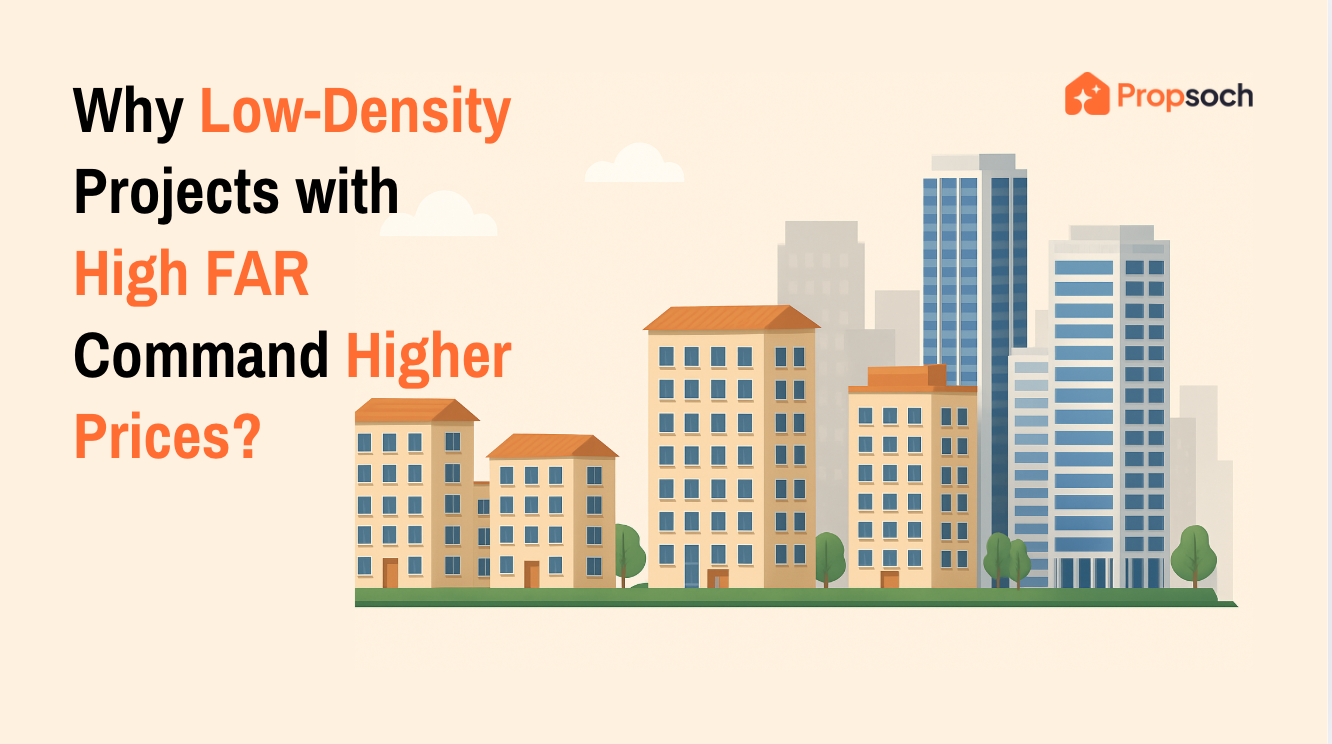When you're evaluating a new home, your attention likely goes to the carpet area, pricing or the builder’s reputation. That’s fair, we often look into the overall project scale and how big the community is but the factor that truly impacts liveability is project density
In simple terms, project density refers to the number of residential units per acre of land - that determines how tightly packed your community is.
In this blog, we break down how density is influenced by factors like FAR (Floor Area Ratio), unit sizes, builder grade and even the year a project has been launched.
This analysis, conducted by the Research team at Propsoch, draws insights from over 50 RERA approved apartment projects across Bangalore, carefully curated to reflect a balanced mix of developer types, average saleable areas and handover timelines.
So let’s dive in.
What is Project Density?
At its core, project density is a simple yet powerful metric. It tells you how tightly packed the homes are within a residential project, essentially, how many units are accommodated per acre of land.
But this number shapes your experience as a homebuyer or investor as it influence open space, ventilation, traffic movement, and social infrastructure load.
A high-density project mean more crowding, fewer open spaces and potentially lower resale value while a low-density project offer better quality of life but come with a higher price tag. Understanding density helps you strike the right balance between value and comfort.
As per our research across 500+ projects in Bangalore:
- High-density projects (98+ units/acre): Maximize land usage, offer smaller units, and target affordability
- Medium-density (70–98 units/acre): Balanced design with decent open space and community areas
- Low-density (<69 units/acre): Spacious layouts, premium pricing, and better long-term livability
Regression Analysis: What Influences Project Density?
We ran a multivariate linear regression to determine how project density (units per acre) is affected by:
- FAR (Floor Area Ratio)
- Average Saleable Area
- Launch Year
- Developer Grade
FSI/FAR and Permissible Construction Volume
FAR (Floor Area Ratio) defines how much built-up area can be constructed per unit of land. It’s a planning guideline but also a key driver of density:
- Higher FAR = More buildable floor area = More units
- Transit corridors (e.g., metro-adjacent plots) often get FAR incentives
We studied over 50 residential projects and found that when the FAR (Floor Area Ratio) increases by 1 point, the number of homes built per acre goes up by around 6 to 7 units.
On the other hand when a project has a high permissible FAR (Floor Area Ratio), developers sometimes choose not to utilize it fully. Instead, they intentionally limit the number of units to maintain low density and offer a more spacious, premium living experience. This strategy is common in luxury projects, where exclusivity and open space are key selling points.
As a result, you may notice that projects with low density but high FAR often come with higher price tags because you're paying not just for square footage but for better livability, privacy and long-term value.
Average Unit Size
This is a crucial and often overlooked factor.
- Smaller average unit size (e.g., 800-900 sqft) = Higher unit count
- Larger average size (e.g., 1500-1700 sqft) = Lower unit density
We ran a linear regression and found that when the average saleable area of homes increases by 100 square feet, the number of units built per acre tends to drop by about 2. This means larger homes usually come with lower density. The trend was strong and reliable across the projects we studied, based on our data model.
Launch Date
Projects launched before 2020 (esp. during the affordable housing push) showed higher density.
Post-COVID launches have changed buyer sentiment:
- Demand for wellness, open areas and less crowding
- Developers are now offering more open space and larger units
*Basis our research, for every year newer the project, density dropped by ~2.4 units/acre.
Developer Grade
Grade A developers show a wide range of densities, but mostly cluster around 60-90 units/acre.
Grade B and C developers show more consistency in the mid to high-density range.
Grade D projects show the highest variability from very low to extremely high density, indicating inconsistency in planning standards.
Conclusion: Why Density Deserves a Seat at the Table?
Project density isn’t just a technical planning metric, it’s a powerful indicator of how a residential community will feel, function and perform over time. Our analysis shows that while FAR, average unit size and launch year play statistically significant roles in shaping density, the story goes much deeper.
Whether it’s a high-rise near a metro station or a sprawling township on the city’s edge, understanding how dense a project is can reveal a lot about its long-term livability, pricing fairness, and resale appeal.
Projects with high FAR but low density often signal a premium living experience with premium value where you're paying not just for space, but for exclusivity, privacy, and better long-term value.
So when buying a home,
- Ask your advisor for the density (units/acre) before comparing projects.
- Consider how density affects long-term livability, especially in smaller land parcels.
- Use density to assess whether pricing and amenities are truly justified.
At Propsoch, we understand that buying a home is one of the most significant decisions you'll make. Our Guided Homebuying Service is designed to provide you with comprehensive, data-driven insights, ensuring you understand not only the upfront costs but also the long-term implications of factors like project density and FAR utilization.
By analyzing over 500 RERA-approved projects in Bangalore, we equip you with insights into how essential factors such as unit size, open space and builder specifications impact both livability and investment potential.
Contact with us today and take the first step towards making your homebuying journey smoother, smarter and stress-free.









